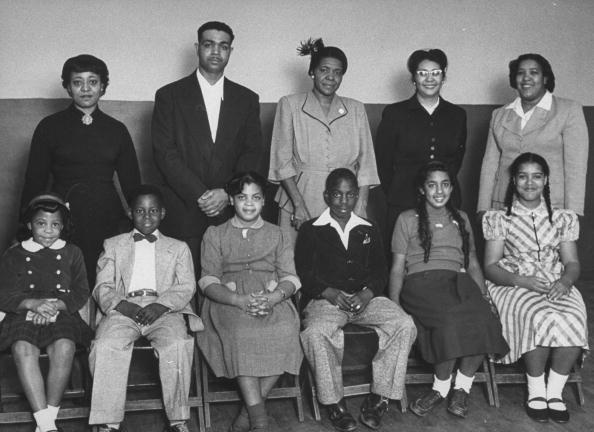Finally, the justices overturned Jim Crow, tossing out ‘separate but equal’ standard
On December 13, 1952, the justices of the U.S. Supreme Court met to consider five cases they had heard argued earlier that week. Those cases raised the most explosive topic any of the jurists would ever have to rule on: whether the Constitution allowed American public school districts to continue to use racial criteria to segregate facilities. Opening the discussion, Chief Justice Fred Vinson admitted, “The situation is very serious and very emotional.”
This was no theoretical matter. In the South, 17 states required public schools to separate students by race, and Kansas, Wyoming, New Mexico, and Arizona permitted school segregation by law. But the country had begun to rethink segregation. In 1947, California had repealed a law mandating separate schools for Asians. The next year, President Harry Truman issued an executive order ending racial segregation in the armed forces and Arkansas desegregated its state university.
The justices had long relied on predecessors’ 1896 decision in Plessy v. Ferguson, which said that it was not a violation of the guarantee of equal protection of the law to consign people of different races—for which read Whites and others—to separate facilities, provided those facilities were equal. But the justices had begun to take baby steps away from the court’s historic pattern of defending school segregation. In the mid-1930s civil rights activists had begun litigating the question of whether educational facilities assigned blacks were in fact equal. These efforts led initally to cases that involved graduate education—not nearly as hot-button a topic as integrating primary and secondary schools would have been.
That tactic generated the first Supreme Court ruling against racial segregation in education. The 1938 decision found that Missouri was not giving equal treatment—and therefore was violating the Constitution—when the state university law school refused to admit a qualified African American, even though the institution offered to pay his tuition at a law school in an adjacent state. In 1950 the court held unconstitutional the Texas policy of maintaining separate, racially segregated law schools, because not only did the school for Whites boast a greater variety of courses and a better library but also enjoyed a superior reputation and “standing in the community.” The same day, the justices embraced an even broader reading of “equal” by holding unconstitutional a University of Oklahoma policy forcing a Black doctoral candidate to sit at a separate table when in a classroom, library, or cafeteria.

The justices knew that any ruling on segregation in grades K-12 would detonate in ways that decisions on post-baccalaureate education did not. So incendiary was the prospect that at that December 1952 meeting the justices decided not to rule on the issue. Without a formal vote, they set the five cases for rehearing in 1953. However, discussion revealed that four justices were ready to ban racial school segregation and four others found the Constitution to permit school segregation, while one—Felix Frankfurter—would ban segregation only in Washington, DC.
Three months before the cases were to be argued again, Chief Justice Vinson died of a heart attack. President Dwight Eisenhower gave California Governor Earl Warren an interim appointment to the Court, allowing him to step immediately into the role of chief justice in time to hear the desegregation cases; Warren’s Senate confirmation, by acclamation, came five months later.
Vinson had favored segregation, infusing Warren’s appointment with huge impact. As governor Warren had spurred California’s repeal of its law dictating separate schools for Asians, and as a justice he could be counted as a fifth vote against segregation, making a majority.
But Warren wanted the Supreme Court to strike down school segregation with a unified voice. He opened the conference after the 1953 re-arguments by saying, “There is great value in unanimity and uniformity, even if we have some differences.” He painted the question of continuing segregation as a moral one, precedent be damned.
“The basis of the principle of segregation and separate but equal rests upon the basic premise that the Negro race is inferior,” Warren told colleagues. “I don’t see how we can continue in this day and age to set one group apart from the rest and say that that they are not entitled to exactly the same treatment as all others.”
Warren’s reasoning closely reflected the oral argument the lead lawyer for the students pressing for integrated schools had made to the court. The NAACP’s Thurgood Marshall, later the Supreme Court’s first African-American member, had told the justices that if they found continued school segregation allowable “the only way to arrive at this decision is to find that for some reason Negroes are inferior to all other human beings.”
Not every justice agreed. “Segregation is not done on the theory of racial inferiority, but of racial differences,” Stanley Reed, the most adamant resister, argued to his colleagues. “It protects people against the mixing of races.” But Warren was able to convince Reed and the other dissenters that, since a majority was going to hand down a contentious ruling deeming school segregation unconstitutional, it would be best for the nation if there were no public disagreement.
That call for unanimity was so compelling that when the decision came on May 17, 1954, Justice Robert H. Jackson left his hospital bed to be with his colleagues in the courtroom.
To underline the ruling’s national nature and make clear that it was not a regional jab at the South, the High Court cited as the first case one brought on behalf of Kansas schoolgirl Linda Brown. Local authorities had barred her from attending her neighborhood elementary; thus the historic title Brown v. Board of Education of Topeka.
Warren wrote the opinion, a mere 13 paragraphs long and devoid of Latinate legalisms. The issue could no longer be whether educational opportunities being offered Black and White students in segregated schools were equal—in the cases before the court, facilities and programs were in fact equal or making significant strides in that direction—but whether separation itself violated the 14th Amendment promise of equal protection under the law. Warren insisted that school segregation by its nature was unequal, inflicting particular harm on children: “To separate them from others of similar age and qualifications solely because of their race generates a feeling of inferiority as to their status in the community that may affect their hearts and minds in a way that is unlikely ever to be undone.” As evidence, Warren unconventionally cited not legal precedent but results of seven sociological and psychological studies showing that Negro children in segregated schools did in fact feel that blacks were inferior.
Warren’s decision acknowledged “a great variety of local conditions” and asked the litigants to recommend how to achieve integration. In May 1955 the chief justice announced the High Court’s second Brown decision, calling for school desegregation to proceed “with all deliberate speed” but telling lower courts overseeing compliance to recognize that they “may find that additional time is necessary to carry out the ruling.”
Change began. However, so many localities resisted that integration was still being fought in 1970. That year President Richard Nixon, declaring Brown “right in both constitutional and human terms,” created a Cabinet-level committee to put federal muscle behind its mandate. But Brown did generate one immediate impact. As lawyer-journalist-professor Roger Wilkins phrased it, the decision was a ringing rebuke to a cultural smear that African Americans had had to grow up with—that they were inherently inferior.
“For me, May 17, 1954 was a second Emancipation Day,” Wilkins declared.
This SCOTUS 101 column appeared in the April 2021 issue of American History





